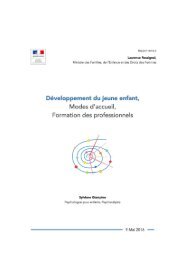agrl_innovations_in_ssa.pdf?utm_content=buffercb41d&utm_medium=social&utm_source=twitter
agrl_innovations_in_ssa.pdf?utm_content=buffercb41d&utm_medium=social&utm_source=twitter
agrl_innovations_in_ssa.pdf?utm_content=buffercb41d&utm_medium=social&utm_source=twitter
Create successful ePaper yourself
Turn your PDF publications into a flip-book with our unique Google optimized e-Paper software.
Of the six categories, market challenges were often the most serious with over 90% of cases<br />
be<strong>in</strong>g affected whether by poorly developed markets – 95%, low prices – 81%, or high <strong>in</strong>put<br />
costs – 91%. All cases were challenged <strong>in</strong> one way or another by poor support services notably<br />
lack of knowledge/poor extension – 100%of cases, lack of access to <strong>in</strong>puts – 90%, lack of credit<br />
– 67% and lack of or <strong>in</strong>appropriate research – 62%. Institutional challenges <strong>in</strong>cluded weak<br />
<strong>in</strong>stitutional structures – 86% and poorly organised farmers – 90%, with conflicts between<br />
stakeholders account<strong>in</strong>g for 48%. With regards to farm<strong>in</strong>g systems, pests and diseases were<br />
stated as be<strong>in</strong>g the greatest challenges – 86% of cases, lack of suitable varieties – 81%,<br />
low-quality produce – 76%, decl<strong>in</strong><strong>in</strong>g production – 67%, and poor NRM – 43%. Clearly these<br />
challenges are <strong>in</strong>terrelated with one often be<strong>in</strong>g the consequence of another.<br />
Inappropriate policy was regarded as a challenge <strong>in</strong> 57% of cases and although poor<br />
<strong>in</strong>frastructure was regarded as a challenge <strong>in</strong> only 38% of cases, poor market<strong>in</strong>g facilities – 95%<br />
of cases were often tied to poor <strong>in</strong>frastructure.<br />
Stakeholders and their roles dur<strong>in</strong>g the <strong>in</strong>novation process<br />
Stakeholders came from the entire spectrum of the public, private, and NGO actors across<br />
the economy, undertak<strong>in</strong>g roles that evolved over time, details of which are shown <strong>in</strong> Annex<br />
1. Interaction, collaboration and coord<strong>in</strong>ation were essential components of all cases, often<br />
achieved through a process that assisted <strong>in</strong> br<strong>in</strong>g<strong>in</strong>g together the actors, chang<strong>in</strong>g attitudes<br />
and build<strong>in</strong>g partnerships based on shared concerns and a need to identify opportunities for<br />
improvements. In some cases farmers themselves took an active role <strong>in</strong> the early stages, but <strong>in</strong><br />
most the public sector took the lead <strong>in</strong> provid<strong>in</strong>g policy guidance, research and other support.<br />
In some cases NGOs or private commercial companies took the <strong>in</strong>itiative with donor fund<strong>in</strong>g<br />
play<strong>in</strong>g an important role <strong>in</strong> most cases.<br />
Coord<strong>in</strong>at<strong>in</strong>g roles<br />
At the start of the <strong>in</strong>novation process responsibility for coord<strong>in</strong>ation was often shared,<br />
especially where primary production and process<strong>in</strong>g activities had not been l<strong>in</strong>ked previously.<br />
Often it was research or another public-sector body that took the lead, with NGOs play<strong>in</strong>g<br />
a support role for farmers especially dur<strong>in</strong>g early stages. In only two cases were farmers<br />
sufficiently organised to take the lead at the start of the <strong>in</strong>novation process, this often be<strong>in</strong>g<br />
triggered by a commodity or sector study presented for stakeholder discussions and lead<strong>in</strong>g<br />
to recommendations to government for policy changes. Special projects, often donor-funded<br />
played an important role <strong>in</strong> coord<strong>in</strong>at<strong>in</strong>g stakeholders, with research often tak<strong>in</strong>g an early lead<br />
(Figure 4 and Table 5)<br />
As the <strong>in</strong>novation process cont<strong>in</strong>ued coord<strong>in</strong>ation often shifted to farmer organisations tak<strong>in</strong>g<br />
greater <strong>in</strong>terest and sometimes assum<strong>in</strong>g leadership as their capacity for this role <strong>in</strong>creased.<br />
Backstopp<strong>in</strong>g for weaker partners formed an important service provided by research, NGOs<br />
and occasionally the private sector. It was also apparent that local or district government<br />
representatives played an <strong>in</strong>creas<strong>in</strong>gly important role, as the research lead reduced and local<br />
capacity and capability <strong>in</strong>creased.<br />
86 Agricultural Innovation <strong>in</strong> Sub-Saharan Africa






